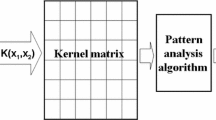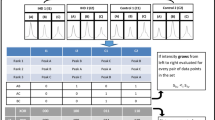Summary
The accurate nonlinear model for predicting the tissue/blood partition coefficients (PC) of organic compounds in different tissues was firstly developed based on least-squares support vector machines (LS-SVM), as a novel machine learning technique, by using the compounds’ molecular descriptors calculated from the structure alone and the composition features of tissues. The heuristic method (HM) was used to select the appropriate molecular descriptors and build the linear model. The prediction result of the LS-SVM model is much better than that obtained by HM method and the prediction values of tissue/blood partition coefficients based on the LS-SVM model are in good agreement with the experimental values, which proved that nonlinear model can simulate the relationship between the structural descriptors, the tissue composition and the tissue/blood partition coefficients more accurately as well as LS-SVM was a powerful and promising tool in the prediction of the tissue/blood partition behaviour of compounds. Furthermore, this paper provided a new and effective method for predicting the tissue/blood partition behaviour of the compounds in the different tissues from their structures and gave some insight into structural features related to the partition process of the organic compounds in different tissues.
Similar content being viewed by others
References
Boobis A., Gundert-Remy U., Kremers P., Macheras P., Pelkonen O., (2002). Eur. J. Pharm. Sci., 17 183
Baláž Š., Luka¶cÏova V., (1999) Quant. Struct. Act. Relat., 18 361
Zhang H.B., (2004) J. Pharm. Sci., 93 1595
Zhang H.B., (2005) J. Chem. Inf. Comput. Sci., 45 121
Ekins S., Obach R.S., (2000) J. Pharmacol. Exp. Ther., 295 463
Cronin M.T.D., (2000) Curr. Opin. Drug Discovery Dev., 3 292
Yoshida F., Topliss J.G., (2000) J. Med. Chem., 43 2575
Belousov A.I., Verzakov S.A., Von Frese J., (2002). Chemometr. Intell. Lab. Syst., 64 15
Morris Colin W., Autret A., Boddy L., (2001) Ecol. Model., 146 57
Burbidge R., Trotter M., Buxton B., Holden S., (2001) Comput. Chem.. 26 5
Liu H.X., Zhang R.S., Yao X.J., Liu M.C., Hu Z.D., Fan B.T., (2003) J. Chem. InfComput. Sci., 43 1288
Liu H.X., Zhang R.S.,Yao X.J., Liu M.C., Hu Z.D., Fan B.T., (2004) J. Chem. Inf. Comput. Sci., 44 161
Xue C.X., Zhang R.S., Liu H.X., Yao X.J., Liu M.C., Hu Z.D., Fan B.T., (2004) J. Chem. Inf. Comput. Sci., 44 669
Liu H.X., Zhang R.S., Yao X.J., Liu M.C., Hu Z.D., Fan B.T., (2004) J. Comput. Aid. Mol. Des. 18 389
Yao X.J., Panaye A., Doucet J.P., Zhang R.S., Chen H.F., Fan B.T., Liu M.C., Hu Z.D., (2004) J. Chem. Inf. Comput. Sci.., 44 1257
Liu H.X., Xue C.X., Zhang R.S., Yao X.J., Liu M.C., Hu Z.D., Fan B.T., (2004) J. Chem. Inf. Comput. Sci., 44 1979
Burges C.J.C., (1998) Data Min. Know. Disc. 2 1
Vapnik V., 1982 Estimation of Dependences Based on Empirical Data, Springer, Berlin
Suykens J.A.K., Vandewalle J., (1999) Neural Process. Lett. 9 293
Katritzky, A.R., Lobanov, V.S. and Karelson, M., Comprehensive Descriptors for Structural and Statistical Analysis, Reference Manual. Version 2.0, 1994
Katritzky A.R., Lobanov V.S., Karelson M., (1995) Chem. Soc. Rev.. 24 279
Oblak M., Randic M., Solmajer T., (2000) ?J. Chem. Inf. Comput. Sci.. 40 994
Katritzky A.R., Tatham D.B., (2001) J. Chem. Inf. Comput. Sci., 41 1162
HyperChem. 4.0, Hypercube, 1994
Stewart J.P.P., MOPAC 6.0, 1989 Quantum Chemistry Program Exchange; QCPE, No. 455, Indiana University, Bloomington, IN
Katritzky A.R., Petrukhin R., Jain R., Karelson M., (2001) J. Chem. Inf. Comput. Sci.. 41 1521
Cortes C., Vapnik V., (1995) Machine Learn., 20 273
Vapnik V., 1998 Statistical Learning Theory, Wiley: New York
Schölkopf B., Burges C., Smola A., 1999 Advances in Kernel Methods – Support Vector Learning, MIT Press: Cambridge, MA
Cristianini N., Shawe-Taylor J., 2000 An Introduction to Support Vector Machines, Cambridge University Press: Cambridge, UK
URL: http://www.kernel-machines.org/,Dec, 2004
Pelckmans, K., Suykens, J.A.K., Van Gestel, T., De Brabanter, D., Lukas, L., Hamers, B., De Moor, B. and Vandewalle, J., LS-SVMlab: a Matlab/C Toolbox for Least Squares Support Vector Machines. Internal Report 02-44, ESATSISTA; K.U. Leuven, Leuven, 2002
Stanton D.T., Egolf L.M., Jurs P.C.J., (1992) Chem. Inf. Comput. Sci.. 32 306
Author information
Authors and Affiliations
Corresponding author
Rights and permissions
About this article
Cite this article
Liu, H., Yao, X., Zhang, R. et al. Prediction of the tissue/blood partition coefficients of organic compounds based on the molecular structure using least-squares support vector machines. J Comput Aided Mol Des 19, 499–508 (2005). https://doi.org/10.1007/s10822-005-9003-5
Received:
Accepted:
Published:
Issue Date:
DOI: https://doi.org/10.1007/s10822-005-9003-5




